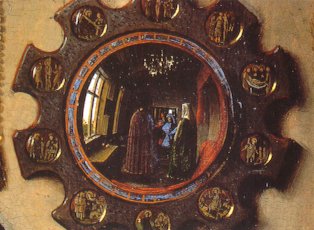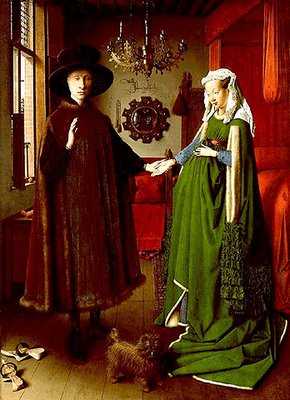

El fantasma de Jan van Eyk
Hola amigos, soy Jan van Eyck, pintor. He venido a Miami por su magnánimo sol... nosotros los pintores flamencos nos fuimos al interior por esa ausencia de luz. No tengo mucho tiempo, pero quisiera presentarles mi pieza más conocida: El retrato del mercader italiano Giovanni Arnolfini y su novia Jeanne de Chenay. La pintura se ha hecho muy famosa con el tiempo. Se trata simplemente de un momento solemne en que Arnolfini y Chenay declaran al mundo la intención de casarse. Disculpen la firma tan ostensiva de mi nombre en la pared sobre el espejo. Me sentía un testigo muy íntimo, como si nada más hiciera falta, salvo ellos, la pintura y yo. Con los siglos se ha dicho que esa obra comienza una nueva etapa en la historia del arte, que no se trata de un cuadro sino una especie de foto. Yo nada sabía. ¿Comprenden? Sólo quise plasmar la pura realidad. Disculpen, no tengo tiempo que perder, hoy es un día tan soleado en Miami...
9 comentarios:
Johannes que bueno oir de ti. Estamos los dos muy orgullosos de tu exito. Que triste es la historia de arte, en cuanto yo y nuestro hermano Lambert te enseñamos a pintar ya nadie nos menciona. En ese pueblecito en que nacimos, en Maaseyck, Limbourg, con ese queso apestoso que comiamos, pasamos buenos tiempos, te recuerdas? Hermanito, las tecnicas tuyas me superaron, y por esa razon es que nuestro nombre ilustre permanece con honor en nuestra familia. Tu obra maestral, el retrato de Arnolfini, que lo veo muchas veces en el museo Nacional de Londres, me recuerda de tu buen sentido de humor. Hermanito, esas cosas tuyas, como de escribir en la pared, sobre el espejo convexo "Johannes de Eyck fuit hic 1434" (Johannes de Eyck estuvo aqui en 1434), todavia nos hace reir! Bueno, hermanito mio, me tengo que ir ya.
TOTZIEN!
Tu hermano Hubert van Eyck
Cheísimo....
Flamencos visitados por flamencos. Caballeros, a veces uno pierde la noción de estar viviendo en Miami
(Por el an~o 1979 se escucha en un radio con un poco de esta'tica): "Paz en la tierra entre los hombres de buena voluntad".
Well tumiami, a puzzle for art experts. In detailing Van Eyck's portrait of the Arnolfini, please note the convex mirror's frame, in which there are 10 pictoral scenes depicted on the frame. These are religious in connotation and somewhat byzantine in form. Of what subject matter are they related, the mysteries of the rosary, the stations of the cross, the life of christ? Perchance, can someone answer this riddle within the frame?
Mano, I don;t know about the riddle. There's a lot of speculation surrounding this particular painting. Jung and Lacan used it. There are a bunch of essays by psychoanalysts on the symbolic qualities. That whole school produced first rate artists, like Dieric Bouts, Memling, van Eyck, Van Der Weyden. Some of the best paintings ever. The genre of still life is theirs. The amount of detail and preciousness (even within camera oscura principles) are simply baffling.
Lo cheo, querida eslinda cifuentes, es una categoría misteriosa y resbaladiza. Lo cheo es amplio y su lectura, o más bien su detección, tiene que ver con el sentido de la ironía, con el humor, con ver un poco más allá de lo que se ve. Por eso entiendo al amigo Pepe Angulo (oye, tremendo nombrecito, Pepe) quien, a juzgar por sus intervenciones previas, conoce a Van Eyck y los Arnolfini. Lo cheo no es el cuadro, sino poner al pobre flamenco a pasar calor en Miami so pretexto de ilustrar a los ¿Bloggistas? ¿bloggeros? ¿amiguitos del blog?. O viceversa, pretender ilustrar a los amiguitos del blog poniendo al pobre flamenco bajo el sol miamense. Y esa descarga "en personaje" sì que es chea..O me equivoco, Pepe?
Yes tumiami,
The phenomena of the "camera-obscura" is mentioned in particular to Vermeers works. Let us not forget Anton van Leeuwenhoek, which not only is credited with the microscope, and the beginning of microbiology, but that in his lifetime he produced over 500 lenses. Prior to Leeuwenhoek, the Dutch worked on the manufacturing of lenses, which were used for the telescope by Galileo Galelie, (which functioned both as an instrument of astronomy but also as one for modern warfare during his time, hence the support for his endeavors by the Medicis).The symbolism and detail of the Dutch School is complex, intermixed (in later years) by Calvinist philosophy and a sensitivity to nature unmatched by many other cultures. This is evident and of special interest during the Burgundian period, both in painting and sculpture, and it's unique format of symbolism and balance as a whole. I must admit that from the period of Bosch and Breugel (lest not forget the Spanish domination of the Netherlands), that I am a product of that love of symbolism and nature intermixed with a "moral compass". Be it my weakness or strength, it is my love, at as time goes by thus does my admiration for these masters.
P.D. Oye Pepe, tienes un angulo fuera de centro!
Seboruco: Pepe y tu se toman las cosas muy en serio. Nada de iluminismo sino seudo-ilustracion y chotedera. Los fantasmas que odian y aman al infierno de Miami son reales, vienen y carenan en la orilla de sus males. Tu sabes de eso...
Publicar un comentario